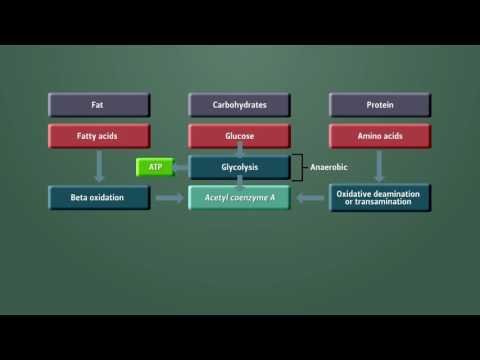Metabolism Module 3 – Fueling Energy Systems

Module 2 explained how ATP is produced by the various energy pathways. The emphasis there was on which substrate, carbohydrate, fat, or protein, was being utilized as fuel. At rest, fats contribute over half of the total daily energy requirements for the body, while carbohydrates contribute over a third, and the rest are supplied by protein. Now let’s take a deeper look at how the energy systems operate during exercise, based on the need for oxygen.
Remember that anaerobic metabolism produces ATP in the cytoplasm of the cell without the need for oxygen. On the other hand, aerobic metabolism, occurring in the mitochondria of the cell, does require oxygen in order to produce ATP but also produces much more ATP than can be produced anaerobically. The important point to remember is that both aerobic and anaerobic processes can and usually do work at the same time. When we’re talking about exercise, the terms aerobic and anaerobic refer to the system that predominates at the time. Before we move on, there is another anaerobic energy system that needs mentioning that will help tie all of this together when we discuss what happens during exercise. This system is called the ATP-PC system. PC stands for Phosphocreatine. Phosphocreatine is not a macronutrient like fat, carbohydrate, or protein. It is a high-energy compound synthesized and stored in our muscles and used to initiate muscle contraction, and is also used during high intensity exercise.
Recall that ATP is comprised of an adenosine molecule and three phosphate molecules. When ATP is used for energy, like during muscle contraction, the energy comes from the chemical bond between the adenosine molecule and one of the phosphate molecules. When the phosphate is cleaved off, this leaves adenosine diphosphate (or ADP) behind. That’s when phosphocreatine comes into play. It transfers its phosphate molecule to adenosine diphosphate and in so doing, regenerates ATP quickly to allow muscle to continue to contract rapidly.
While this sounds like a perfect solution to keep our muscles contracting, the small store of phosphocreatine is only enough to keep our muscle contracting maximally for several seconds. So that bit of information will make this next part make a little more sense. In this diagram, you can see the relative contributions of the ATP-PC system we just learned about, compared to the more robust anaerobic glycolysis and aerobic energy systems.
It’s pretty easy to see that for very short duration exercise, the contribution of the ATP-PC system to ATP production is the highest, but as exercise duration extends to about one minute, almost all ATP production is accomplished by glycolysis and the aerobic systems that include the Krebs cycle and the electron transport system and oxidative phosphorylation. As exercise duration increases further into minutes and even hours, the contribution of the ATP-PC system is very low, and the anaerobic glycolysis system shuts way down in favor of the aerobic pathways, which can produce ATP so much more efficiently using oxygen. You may be asking yourself, “if the aerobic energy system is so much more efficient, why doesn’t it work all the time?” The reason is that when we exercise at a high intensity or when we initiate exercise, the demand for ATP exceeds the capacity of the aerobic pathways to produce it.
The aerobic systems are predominant during activities that last minutes to hours but can’t produce ATP fast enough when exercise intensity is high. One of the limitations of producing ATP using anaerobic pathways is that our bodies store only a limited amount of phosphocreatine in the muscle and carbohydrate in the form of glycogen in the muscles and the liver. By comparison, we have enough energy stored in our fat cells to run for almost 90 hours continuously! The other limitation of anaerobic metabolism is that when intensity is high, pyruvate is not converted into acetyl CoA to enter the aerobic pathways, but instead is converted to lactate until exercise intensity is reduced. Once intensity decreases, the aerobic pathways can once again predominate. Lactate is then converted back to pyruvate to then make acetyl CoA, which enters the mitochondria and the aerobic pathway can continue. In summary, very short-duration, very high-intensity activities rely predominantly on energy sources stored directly in the muscle fibers, like ATP-PC and glycogen.
The lower the intensity, the more important fat is as a fuel. The higher the intensity, the more important carbohydrates are as a fuel. Duration has a similar effect. The shorter the duration, the more important carbohydrates are as fuel. Fats come into play as duration gets longer. Proteins may account for up to 15% of the total energy supply in activities lasting more than an hour. A complex interaction certainly exists between our energy needs during exercise and the fuel sources that provide this energy. .
As found on Youtube

